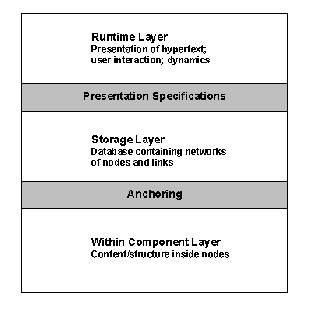Dexter Hypertext Reference Model
The Dexter Hypertext Reference Model captures the important abstractions
found in a wide range of existing and future hypertext systems
[Halasz & Schwartz, 1990].
The goal of the model is to provide a systematic basis for
comparing systems and to develop interchange and interoperability standards.
The Dexter model divides a hypertext system into three layers (See Figure 6.4):
-
Runtime Layer
This layer deals with the presentation of hypertext and the dynamics of user
interaction. Since it is too broad and diverse to be developed into a generic
model, the Dexter model does not go into the details of the presentation
mechanism. However, presentation mechanisms can be specified containing
information about how a component/network is to be presented to the user. These
presentation specifications provide an interface between the runtime layer and
the storage layer.
-
Storage Layer
This is the main focus of the Dexter model. It models a database that is
composed of a hierarchy of data-containing components which are interconnected
by relational links. Components have unique identifiers and links can be
identified by a set of two or more component identifiers. Components correspond
to the general notion of nodes and can contain text, graphics, images, audio,
video etc. The components are treated as generic containers of data and the
model does not specify any structure within the containers. Thus, the storage
layer does not differentiate between text components and graphics components. It
focuses mainly on the mechanism by which components and links are tied together
to form hypertext networks.
-
Within Component Layer
This layer is concerned with the contents and structure within components of
the hypertext network. Since the range of possible content/structure that can be
included in a component is open-ended, the Dexter model treats this layer as
being outside its scope. The assumption is that document structure models such
as ODA, SGML, IGES etc., will be used in conjunction with this model to capture
content/structure. However, a critical interface between the storage layer and
the within-component layer called anchoring discusses the mechanism of
addressing locations or items within the content of an individual component.
Anchors can identified by a unique anchor identifier.
Halasz and Schwartz claimed that no existing systems support all the
mechanisms discussed in the Dexter model. However, existing systems are yet to
be fully compared to this model. The model has been used in developing the
Dexter Interchange Format, a hypertext interchange standard.
Hypermedia structures and systems assignment by
Mark de Haas (0481832)
